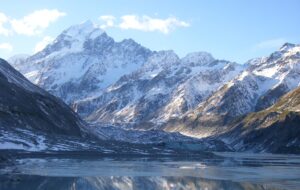The lovely Peruvian peak comes with many dangers, especially this year.
Alpamayo is one of the candidates for the most beautiful peak in the world. Its scenic setting in the northeast corner of Peru’s Cordillera Blanca and especially the Northwest Face with its fluted ice funnels, make it among a handful of contenders.
While not the tallest peak in the range at 5,947m — the massif’s roof is Huascaran, at 6,567m — its fame attracts a large number of climbers. This sometimes leads to overcrowding. And according to Summit Post, over half the climbers eventually turn back because of the peak’s sustained steepness.

Seracs on Alpamayo. Photo: Fotis Theocharis
In addition, Alpamayo’s location makes it vulnerable to frequent clouds from the nearby Amazon rainforest. Bad weather and thick fog are more common here than on other Peruvian mountains.
The best time to climb Alpamayo is from June to September. While technically winter, its location near the equator makes the cold season irrelevant, and the weather is drier then.
Climbers flock to the Southwest Face
While the peak’s first ascensionists climbed its North Face, the two better-known routes run up the famous SW Face. Casimiro Ferrari led an Italian group up one line on that face in 1975. Its disadvantage is that it passes close to several big seracs. So the Vasque-French route has become the standard way up Alpamayo.

Approaching Alpamayo’s col in fog. Photo: Fotis Theocharis
Both the Vasque-French and the Ferrari routes are sometimes wrongly named the French Direct. This is, in fact, a different, longer line. Its first climbers actually came from the U.S., but they named the route after two Frenchmen who had died on the mountain just two days before.
The online topos and climbers’ comments about Alpamayo are quite confusing because the lines seem to vary with the source. But the fact is, the French Direct goes straight to the main summit, while the other two go up flutings further to the left until they eventually reach the summit ridge.

This topo by an Italian expedition states that n.1 is the Ferrari route, n.2 is the Vasque-French line and n.3 is the French Direct. Photo: Montagna.tv
Alpamayo is considered a relatively safe mountain, as long as conditions are right. The main danger on the standard route is the potential collapse of one of the seracs along the route or the cornices along the summit ridge. One of these broke and killed eight climbers in 2003.

A drone’s-eye view of an overhanging cornice on the Alpamayo summit ridge. Photo: Fotis Theocharis
Fotis Theocharis’ report
This year, the hazards are again high, as the first teams on the mountain only discovered when they were already on their way. That was the case with Greek climber Fotis Theocharis. After attempting K2 and Broad Peak last year, he is currently climbing in South America.
“I was in the Alpamayo high camp at 5,538m on June 9 with guide Miguel Martinez,” Theocharis told ExplorersWeb. “The day before reaching the high camp, I saw a group of over 15 climbers who hadn’t even tried to climb the mountain.”

High camp at the col. Photo: Fotis Theocharis
The climbers who aborted said later that the French Direct route was right under an overhanging cornice and was just too dangerous. Theocharis and his guide decided to try anyway. Unfortunately, by the time they reached the col, thick fog wrapped the mountain. They had no way to see the face.

Alpamayo’s summit ridge looks delicate this year. Drone photo: Fotis Theocharis
On the second day at the col, the weather cleared and they saw the dangerous cornice looming over the route. They tried to find a detour by scouting the face with Theocharis’ drone.
“We decided to try a route to the left of the French Direct and to the right of the Ferrari route,” Theorachis said. “A German climber and a guide joined us and we set off together.
“The route traverses to the left of the French Direct. Unfortunately, on the first 35˚to 40º pitch, we found a slab of frozen snow with soft, loose snow underneath. Knowing about avalanches, we knew we had to go down.”

On the route’s lower sections. Photo: Fotis Theocharis
As if to confirm their caution, the climbers saw large slab avalanches on Alpamayo’s neighboring peak, Quitaraju (6,036m). Check the 360º perspective below and a set of 30 pictures Fotis shared on FaceBook.
The Greek climber estimates that the French Direct route will not be ready to climb until the cornice falls, and the upper sections of the mountain will remain delicate no matter what the route.
“Yet I am sure someone will climb the mountain this season when conditions improve,” he said.
Theocharis has remained in Peru and recently climbed Hurapasca successfully.
Huaraz-based guide Pablo Bello of Adeanraju Expeditions confirmed that Alpamayo has a dangerous serac on the upper sections.
“The route has not yet been opened this season and I am not sure when will it be,” Bello said. “Definitely, it will not be the Vasque-French route but rather, the same line we used last year [the French Direct?] with some variations.”






